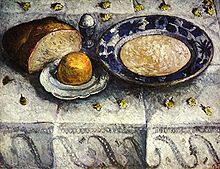Milk satiety

A Milchsatte , also Milchsette or cream bowl , is a special vessel made of ceramic, enamel or glass for the pre-industrial dairy industry. It serves the skimming of raw milk .
In terms of shape, the milk saturation corresponds to a wide-open bowl or a Schottel with a conical wall. The raw milk is filled into this and left to rest. This will allow the milk to separate from the cream. The fatty cream floats and can be skimmed off. Milk satays have a capacity of 5 to 25 liters.
In the late 19th century, satellites were manufactured industrially and some were provided with sieve inserts and spouts on the bottom of the vessel. Well known is a patented stoneware form from Jacob Plein-Wagner & Sons from the town of Speicher in the Eifel , of which around one million were sold between 1886 and 1910. With the introduction of the milk centrifuge and the emergence of cooperative dairies at the end of the 19th century, milk sati fell out of use.
In archaeological excavations , Milchsatten are often represented in the inventories of city core excavations and modern settlement finds .
literature
- Bärbel Kerkhoff-Hader: The potters' way of life and work in the South West Eifel. A contribution to stoneware research in the Rhineland. Rheinisches Archiv 110. Bonn 1980. S. 203.
Web links
- Erich Maletzke: "Devilish machines and enameled milk satellites" - Schleswig-Holstein at world exhibitions , online text version (PDF; 5.2 MB)
Individual evidence
- ↑ Kerkhoff-Hader 1980, p. 203.
- ↑ Article about Plein-Wagner on eifelzeitung.de.